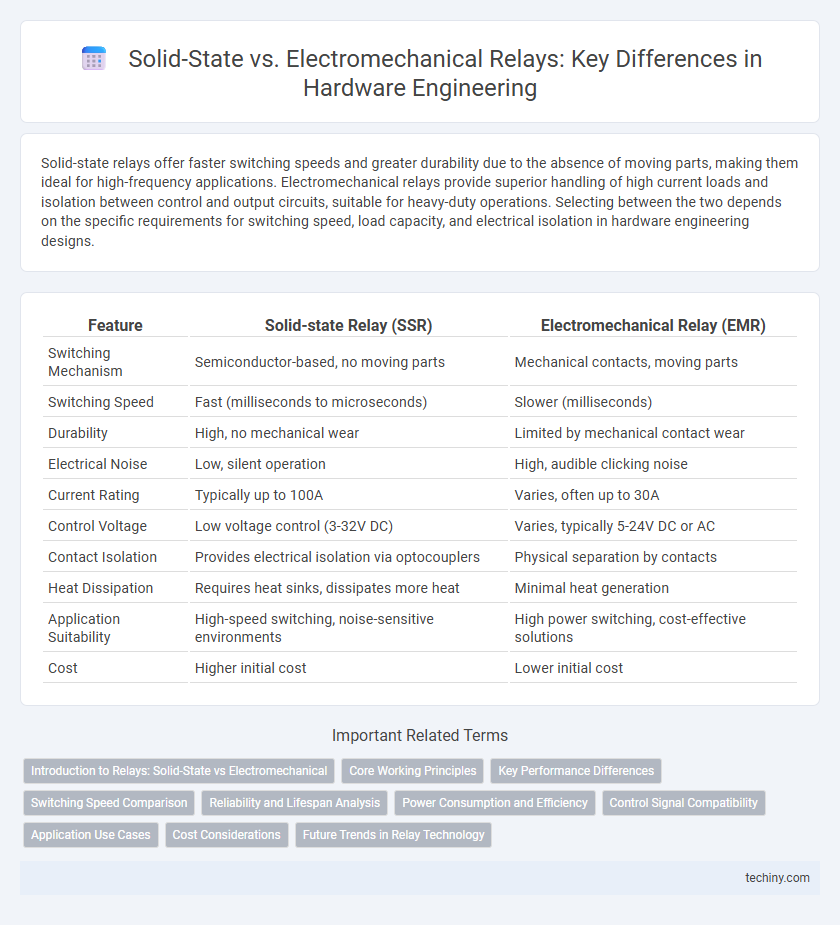Solid-state relays offer faster switching speeds and greater durability due to the absence of moving parts, making them ideal for high-frequency applications. Electromechanical relays provide superior handling of high current loads and isolation between control and output circuits, suitable for heavy-duty operations. Selecting between the two depends on the specific requirements for switching speed, load capacity, and electrical isolation in hardware engineering designs.
Table of Comparison
| Feature | Solid-state Relay (SSR) | Electromechanical Relay (EMR) |
|---|---|---|
| Switching Mechanism | Semiconductor-based, no moving parts | Mechanical contacts, moving parts |
| Switching Speed | Fast (milliseconds to microseconds) | Slower (milliseconds) |
| Durability | High, no mechanical wear | Limited by mechanical contact wear |
| Electrical Noise | Low, silent operation | High, audible clicking noise |
| Current Rating | Typically up to 100A | Varies, often up to 30A |
| Control Voltage | Low voltage control (3-32V DC) | Varies, typically 5-24V DC or AC |
| Contact Isolation | Provides electrical isolation via optocouplers | Physical separation by contacts |
| Heat Dissipation | Requires heat sinks, dissipates more heat | Minimal heat generation |
| Application Suitability | High-speed switching, noise-sensitive environments | High power switching, cost-effective solutions |
| Cost | Higher initial cost | Lower initial cost |
Introduction to Relays: Solid-State vs Electromechanical
Solid-state relays use semiconductor components to switch circuits without moving parts, offering faster switching speeds, longer lifespan, and better resistance to shock and vibration. Electromechanical relays rely on physical contacts and electromagnets to open or close circuits, providing high current capacity and electrical isolation but with slower response times and mechanical wear. Choosing between solid-state and electromechanical relays depends on application requirements such as switching speed, load type, and environmental conditions.
Core Working Principles
Solid-state relays operate using semiconductor components such as thyristors or triacs to switch circuits without mechanical parts, enabling faster switching speeds and increased durability. Electromechanical relays rely on an electromagnetic coil that, when energized, physically moves contacts to open or close circuits, offering clear electrical isolation and simple design. The core principle difference lies in solid-state relays using electronic switching devices for contactless operation, while electromechanical relays employ mechanical movement for circuit control.
Key Performance Differences
Solid-state relays offer faster switching speeds and longer operational lifespans compared to electromechanical relays, which rely on physical contacts prone to wear and mechanical failure. Electromechanical relays typically provide higher current and voltage handling capabilities but generate audible clicking noise, whereas solid-state relays operate silently and with lower electromagnetic interference. Thermal performance and surge resistance vary significantly, as solid-state relays have integrated heat dissipation mechanisms while electromechanical relays are more susceptible to contact arcing and mechanical degradation under high transient loads.
Switching Speed Comparison
Solid-state relays (SSRs) exhibit significantly faster switching speeds, typically in the range of microseconds, compared to electromechanical relays (EMRs), which operate in milliseconds due to mechanical movement. The absence of physical contacts in SSRs eliminates contact bounce and allows near-instantaneous state changes, making them ideal for high-frequency switching applications. Electromechanical relays are limited by coil energizing time and mechanical inertia, resulting in slower response times and increased wear over repeated cycles.
Reliability and Lifespan Analysis
Solid-state relays (SSRs) exhibit superior reliability and longer lifespan compared to electromechanical relays due to the absence of moving parts and reduced wear from mechanical switching. SSRs typically offer lifespans exceeding 100 million cycles, while electromechanical relays usually last around 10 million cycles depending on operating conditions and load types. The enhanced durability of SSRs reduces maintenance needs and failure rates, making them ideal for high-frequency switching and mission-critical hardware engineering applications.
Power Consumption and Efficiency
Solid-state relays (SSRs) consume significantly less power than electromechanical relays (EMRs) due to the absence of mechanical movement and coil excitation, resulting in higher energy efficiency. SSRs offer faster switching speeds and reduced heat generation, contributing to lower overall power loss in industrial applications. Electromechanical relays require continuous coil current to maintain the switch state, leading to increased power consumption and reduced efficiency in continuous operation scenarios.
Control Signal Compatibility
Solid-state relays (SSRs) offer better control signal compatibility due to their ability to operate with low-voltage DC signals, making them ideal for microcontroller and digital logic interfaces. Electromechanical relays (EMRs) typically require higher coil voltages and current levels, limiting their direct use with modern low-power control circuits. This fundamental difference impacts integration flexibility and overall system design in hardware engineering applications.
Application Use Cases
Solid-state relays (SSRs) excel in applications requiring fast switching, silent operation, and long lifespan, such as industrial automation, HVAC systems, and precision control in medical devices. Electromechanical relays (EMRs) are preferred in high-voltage, high-current scenarios like power distribution, automotive systems, and heavy machinery due to their robust physical contacts and ability to handle voltage spikes. Understanding the distinct advantages of SSRs and EMRs enables engineers to select the optimal relay type tailored to the reliability, speed, and electrical environment of specific hardware designs.
Cost Considerations
Solid-state relays (SSRs) typically have a higher upfront cost than electromechanical relays (EMRs) due to advanced semiconductor materials and manufacturing processes. Electromechanical relays are generally more cost-effective for low-volume applications and environments where switching speed and noise are less critical. Long-term expenses favor SSRs in high-cycle or harsh environments because of their longer lifespan and reduced maintenance requirements.
Future Trends in Relay Technology
Future trends in relay technology emphasize increased adoption of solid-state relays (SSRs) due to their faster switching speeds, longer lifespan, and superior resistance to mechanical wear compared to electromechanical relays (EMRs). Innovations in semiconductor materials and integration techniques are driving improvements in SSR power handling and thermal management, enabling their use in high-voltage and high-current applications traditionally dominated by EMRs. The shift toward smart grid systems and IoT devices demands relay solutions with enhanced reliability, miniaturization, and digital communication capabilities, positioning solid-state relays at the forefront of hardware engineering advancements.
Solid-state vs Electromechanical Relay Infographic

 techiny.com
techiny.com